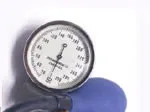~120/80
That’s a healthy blood pressure reading, according to Tasmania-based cardiologist Dr Warrick Bishop. So what exactly is blood pressure? Think of it as the force of blood as it’s pumped around the body by the heart. The first number – systolic blood pressure – is the force caused by your heart pushing blood into your arteries. The second number, called diastolic blood pressure, is the force when your heart fills with blood.
While 120/80 is ideal, Dr Bishop says it’s used as a guide. “Blood pressure is an indicator of how your heart is functioning. Generally, high blood pressure (hypertension) is anything over 139/89 while low blood pressure (hypotension) is anything under 90/60,” he explains.
“From a practical point of view, the lower the blood pressure, the less work your heart has to do. That said, if it becomes too low, you might feel lightheaded, dizzy, or even faint. It’s important to remember your blood pressure doesn’t stay the same and that it’s easily affected by other factors.”
These include changes in body position, breathing, emotional state, exercise and sleep.

~4
Is the amount of salt, in grams, you should be reducing your salt intake to in order to maintain a healthy blood pressure. “Too much salt makes you thirsty and your body tries to compensate by storing extra water, which raises your blood pressure,” Dr Bishop says.
The higher your blood pressure is, the greater the strain on your heart, arteries, kidneys and brain. This can lead to heart attack, stroke, kidney disease, and dementia. Nutrition Australia advises sticking to no more than 4g of salt a day (equating to 1.6g sodium), which is about half the average Australian adult’s current salt intake.
“There’s strong evidence to suggest that we should try to minimise our salt consumption because our current intake is much more than what we actually require,” Dr Bishop says.
Always read labels to check for the hidden salt in processed foods and reach for more herbs and spices when you’re cooking.

~30
That’s the number of minutes of exercise you should be aiming for a day. Just a half-hour of brisk walking can lead to incredible changes in your health, especially blood pressure.
Studies show moderate-intensity activities such as walking, swimming or dancing help to lower or keep your blood pressure under control when done regularly. The results are based on half-hour bursts of moderate-intensity activity, but Dr Bishop says any regular physical activity can be helpful.
“Exercise is critical for maintaining mobility and health but if you don’t like doing it, you won’t stick with it,” he adds. “Find something sustainable that you’ll enjoy doing regularly. If you enjoy spending time with your dog, take advantage of the opportunity for incidental exercise by walking him every day for half an hour.”
Check with your GP before any new exercise program.

~5
Kilograms can make a huge impact to your blood pressure – more so if you can shed it from your waistline. Yes, losing your muffin top is one of the best ways to lower blood pressure and reduce your diabetes and cardiovascular disease risk.
Excess abdominal fat – particularly the kind that surrounds your organs (visceral fat) – can be a sign you’re headed for heart disease, diabetes, insulin resistance or cancer.
“It’s a different type of fat that is part of a condition called metabolic syndrome, but it can also be the result of genetics which make you prone to put on weight around your midsection,” Dr Bishop says. Currently more than 35 per cent of Australian adults have metabolic syndrome.
If you already have hypertension, losing 5kg of excess fat can help to lower blood pressure, in turn reducing your risk of diabetes and cardiovascular disease. Other benefits may include a reduced dose of blood pressure medication.
“In general terms, a 5-10kg loss is the equivalent of one medication,” Dr Bishop says. Always check with your GP before changing any medication.
~6
Is the minimum number of sleep for optimal heart health. “One of the things we’ve become more aware of is the importance of getting enough sleep and its impact on the heart,” he says.
Getting fewer than six hours a night may be linked to higher blood pressure as sleep helps regulate stress hormones and keeps your nervous system healthy.
“Over time, a lack of sleep can trigger sympathetic overdrive, which is responsible for the fight or flight response, resulting in high blood pressure,” Dr Bishop explains.
If you struggle with insomnia or wake up feeling tired, talk to your GP about whether you may have obstructive sleep apnoea.
“If you snore and stop breathing during sleep, your body tends to feel a lack of energy,” he adds.

~60
Is the age at which you should have regular check-ups. High blood pressure is more common in women over 60, possibly due to changes in blood vessels. “That’s when your risk of a cardiovascular problem rises to 10 per cent in 10 years,” Dr Bishop says.
Once you know your numbers, it’s recommended to have your blood pressure checked at least every two years, more often if it’s high or there’s a family history, and perhaps a diagnostic scan of your heart.


